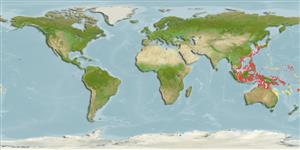Preferred temperature (Ref.
123201): 23 - 28.9, mean 27.7 °C (based on 440 cells).
Phylogenetic diversity index (Ref.
82804): PD
50 = 0.5000 [Uniqueness, from 0.5 = low to 2.0 = high].
Bayesian length-weight: a=0.00955 (0.00394 - 0.02313), b=2.96 (2.75 - 3.17), in cm total length, based on LWR estimates for this (Sub)family-body shape (Ref.
93245).
Trophic level (Ref.
69278): 3.3 ±0.4 se; based on size and trophs of closest relatives
Resilience (Ref.
120179): High, minimum population doubling time less than 15 months (Preliminary K or Fecundity.).
Fishing Vulnerability (Ref.
59153): Low vulnerability (10 of 100).
Nutrients (Ref.
124155): Calcium = 55 [22, 115] mg/100g; Iron = 0.364 [0.191, 0.671] mg/100g; Protein = 19.1 [17.9, 20.2] %; Omega3 = 0.439 [0.210, 0.921] g/100g; Selenium = 5.45 [2.30, 13.29] μg/100g; VitaminA = 80.7 [18.9, 347.3] μg/100g; Zinc = 1.1 [0.7, 1.8] mg/100g (wet weight);
